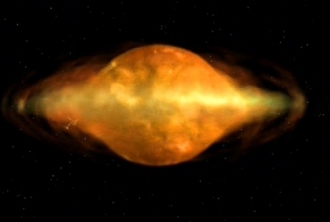
In Star Trek, a graviton ellipse was a stable pocket of normal space moved by a surrounding elliptical concentration of graviton particles, called gravimetric distortions. The graviton is an elementary particle that transmits the force of gravity. Graviton ellipses traveled through subspace, emerging into normal space and extra-dimensional realms only when they were in proximity of objects that emited electromagnetic energy, such as spacecraft and dark matter asteroids. The ellipses themselves generated an electromagnetic radiation field that made the anomaly react like a magnet drawn to another magnet. In the Star Trek: Voyager episode "One Small Step", one such graviton ellipse attempted to devour USS Voyager and was referred to as the "kitchen sink anomaly" due to the debris field contained inside.
 The graviton
ellipse encountered by the USS Voyager
The graviton
ellipse encountered by the USS VoyagerIn actual physics, the graviton is indeed a hypothetical elementary particle that mediates the force of gravity in the framework of quantum field theory. Somewhat similar to the way that our eyes would detect the presence of light by observing photons (which are the carrier packets of light), the gravitational attraction between masses would be the result of the emission of gravitons. The more massive the object, the more gravitons which it would emit, and the more gravity which would be detected between masses.
Although physical detection of individual gravitons is not yet possible, experiments to detect gravitational waves, which may be viewed as coherent states of many gravitons, are already underway. Although these experiments cannot detect individual gravitons, they might provide information about certain properties of the graviton. For example, if gravitational waves were observed to propagate slower than the speed of light in a vacuum, that would imply that the graviton has mass.


Detection of gravitational waves may reveal
more about the properties of gravitons